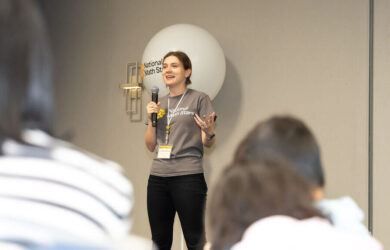Men who are walking with a girlfriend or wife slow their pace to match their partner's, according to research by a Gates Cambridge Alumna.
Men who are in love adapt their walking pace so they are in step with their partner, according to new research led by a Gates Cambridge Alumna.
Cara Wall-Scheffler‘s research, published in PLOS ONE, found that men walking with their romantic partner walked at a significantly slower pace to match their partner’s pace while women’s pace barely changed. Men walking with women friends did not particularly slow their pace.
Previous research has shown that individuals have an optimal walking speed – a speed which minimises energy expenditure for a given distance. Because this varies according to people’s size and the length of their legs, the researchers wanted to look at how it also varies with sex.
Cara [2001], currently a biologist at Seattle Pacific University, led the study which involved 11 couples, along with their male and female friends, walking several times around a track on their own and in different pairings.
Cara says males in any given population tending to walk on average 7% faster than women which potentially creates “an energetic dilemma for mixed-sex walking groups” and explains why, in energetically demanding environments, we might expect to find gender segregation in group composition, particularly when travelling longer distances. She puts the difference down to evolutionary needs in hunter gatherer groups to protect women’s fertility by not forcing them to overexert themselves.
Cara, who did a PhD in Biological Anthropology at the University of Cambridge, says: “There are two important pieces of information to take away from this research: firstly, that people’s relationship status and emotions directly play out into their walking behaviour and secondly, that when we as researchers build predictive models of behaviour (for example, how a group might travel together), the composition of the group is going to have a substantial influence on how the behaviour will actually unfold.”
The research has been covered in a variety of publications, including USA Today and Science Daily.












